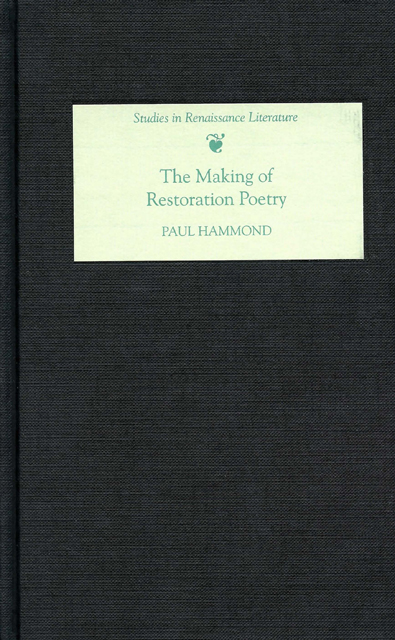Introduction: Poetry, the Public, and the Private
Published online by Cambridge University Press: 18 March 2023
Summary
Like many binary oppositions, the antithesis between the ‘public’ and the ‘private’ is conceptually crude, and tends to obscure more than it illuminates. Yet if we keep in view the instability of these terms, they can be useful in identifying the ways in which Restoration poetry shapes complex forms of public discourse and of private reflection. When the restored Charles II saw the crowds which greeted him in May 1660 as he rode into London, he remarked that it was evidently his own fault that he had been away so long, since he had not met anyone who did not wish for his return. The irony in the king's remark shows that he was well aware that public opinion was not unanimous; indeed, the very notion of public opinion, in the singular, is dubious in this context. In 1660 there were many constituencies: principled republicans, pragmatic civil servants, opportunistic new royalists, long-suffering cavaliers, disappointed Nonconformists, triumphant Anglicans, unobtrusive Catholics – and any of these labels is liable to dissolve on contact with the complexities of individual beliefs and practices. But a study of Restoration poetry can map some of the ways in which forms of the public and the private were created.
The presentation of the new king was itself a public fiction – and one element in that fiction was the denial of the word ‘new’. Charles dated his reign from 30 January 1649, the date of his father's execution, so according to official calculations his return in May 1660 fell in his twelfth regnal year. The time when Charles was in exile in France or in flight from his defeat at the Battle of Worcester was therefore presented as the first decade of his reign, so that a public fiction was laminated over what had actually been experienced. Poets began by celebrating his return through the imagery of Charles as Augustus or as David, which implied an imperial or providential narrative, but Dryden in Astraea Redux, while using both mythologies, pondered also the nature of the time and the implementation of the vocabulary.1 The definition of mythology offered by Roland Barthes illuminates some of the modes through which poetry shaped a mythology for the public realm:
Ce que le monde fournit au mythe c’est un réel historique… et ce que le mythe restitue, c’est une image naturelle de ce réel…
- Type
- Chapter
- Information
- The Making of Restoration Poetry , pp. xiii - xxivPublisher: Boydell & BrewerPrint publication year: 2006



